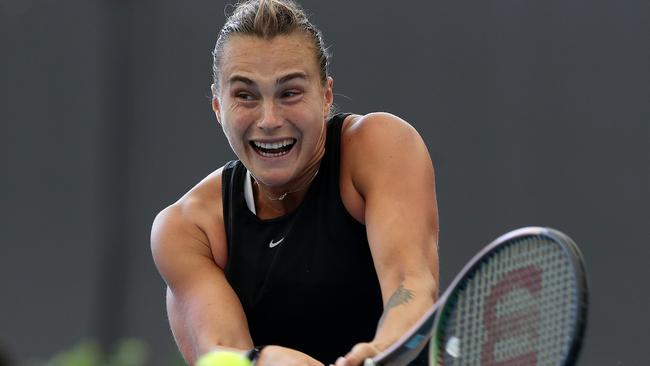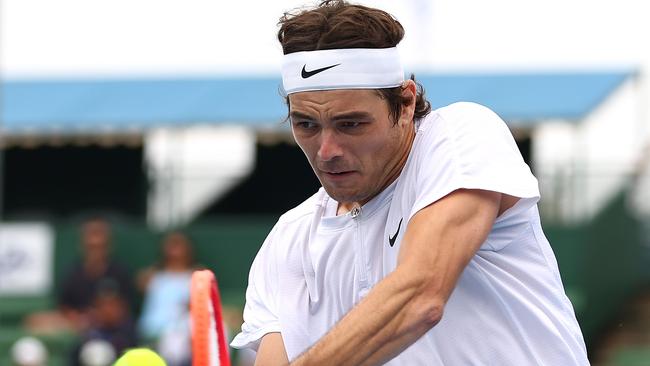Open slather: Almost anything can happen at Melbourne Park
The Australian Open starts on Monday. What will happen? Here’s what.

There is always anticipation around the first grand slam of the year. Who’s on the rise, who’s on the way out and who’s set to surprise.
Here are eight predictions you can (almost) bank on to come to fruition over the next fortnight at Melbourne Park.
Will Kyrgios win it?
Nope. His body is a 193cm question mark. Times of practice sessions keep landing in the inbox and at the moment of writing, he’s yet to have a hit. Was the exhibition against Novak Djokovic on Friday his only guaranteed start at Melbourne Park? His fitness is a worry even when he’s fit, if you know what I mean. Endurance ain’t a forte. He’s played one tournament in five months, forfeiting his last match to Taylor Fritz in Tokyo.
He’s missed all the lead-ins because of niggles even more deflating than tennis’ mostly boring Netflix doco. Kyrgios may play the best tennis of the tournament – and still not win it.
Because he won’t play it for long enough. Wimbledon last year was his big chance. The dream draw, the weakened field, Djokovic wasn’t in great form going into their final. When push came to shove, Kyrgios’ on-court immaturity cost him clearly and dearly.
That won’t change. Because he doesn’t accept the need for change. So the tennis will be high-voltage, charismatic, scintillating and downright brilliant … before someone else lifts the trophy.
Winning seven straight matches at a slam is a gruelling task in mind, body, brain, heart and spirit … a task still beyond him. If only by a match or two.
What will Demon do?
Scrap. Claw. Fight. Brawl. Squint. Grimace. Run. Run. Run. Charge the net like he’s stolen something. Throw himself round the back-court like he’s on fire. Gesticulate. Pump himself up to the eyeballs. Pump himself up to Lleyton Hewitt’s eyeballs. Feed off Hewitt’s courtside energy. Ride the full-throated support of Melbourne crowds who admire his heart-on-sleeve willingness to have a crack.
The best tennis player on earth would have Kyrgios’ devilish game and de Minaur’s angelic attitude. A tough angel. He never gives up, never concedes an inch, gives more, more, more, fighting with all the gristle and grunt and grit of the sport’s most redoubtable figures – Hewitt, Jimmy Connors, Serena Williams and Rafael Nadal – in a classic example of a bloke punching above his weight.
He’s of slender build at 183cm and 69kg and is handcuffed by a serve inferior to his peers. That’s the problem. An insurmountable one? He gets few freebies from it, which means he never gets a breather, which means he has to work to the bone just to hold serve, let alone break the other bloke’s. He’s the fastest player on tour because he needs to be, zipping around like an Australian Kelpie.
Those dogs run at up to 72km/h. De Minaur’s probably at 73. Quicker than a Kelpie, surely, but as ever he risks being blown through the back wall by the heaviest hitters.
Great viewing is assured. For the sweat-soaked, lion-hearted, against-a-few-odds sincerity of effort.
Is Djokovic beatable?
Maybe not! Best-of-three-sets, yes. He only just snuck past Petr Korda’s kid in Adelaide. Anyone’s somewhat vulnerable in short tour matches. Best-of-five on a court so suited to Djokovic’s machinegun groundstrokes that he might have designed the playing surface himself … it’s just such a hard slog to go the distance with him.
He can lose a set or even two but then he locks into marathon mode. Starts playing like a brick wall. Does. Not. Miss.
Starts bouncing the ball a million times before serves. Annoying niggles. Bungs on imaginary physical ailments, or exaggerates minor aches and pains, or makes it clear how heroic he is to soldier on despite some real issues.
Hats off to him. His job is to win. He does it. You need real physical stamina to go with him and then the mental toughness to concentrate for three, four or five hours.
Nadal went toe-to-toe, shoulder-to-shoulder, forehand-for-forehand, death-stare-for-death-stare with his old mate for six hours in 2012 … and still lost! I suspect the 35-year-old Djokovic is on the crest of a gradual decline.
He’ll be more vulnerable as this and the ensuing years roll on – but his air of invincibility inside the perfumed parlour of Rod Laver Arena is real. The nine-time champion feels it and so do most opponents. He could arrive at Melbourne Park in kingly robes and crown and it wouldn’t look ridiculous. Loves a grudge and even if he doesn’t admit to this … he’ll relish winning the Open a year after the Australian government humiliated and shocked him by kicking him out of the country.
Men’s dark horse?
Kyrgios. A world No.22 is bolter material but let’s leave him out. I’d like to say world No.24 de Minaur, who can realistically pop up in the quarter-finals and from there, who knows? But I just don’t think he has the weaponry to run the entire gauntlet. What you’d really love to see is Kyrgios versus de Minaur, fire versus ice, thunder versus the wind. Rafa? He’s such an injury crock that he nearly qualifies as a dark horse as top seed. Matteo Berretini has the biggest forehand in the world – I saw a great typo this week that said he had the biggest forehead in tennis – but the big lug’s wavering fitness complicates matters at the end of majors.
I like Taylor Fritz. The world No.9 American is a laconic, naturally gifted rather beautiful strokemaker and aged 25, he’s about to peak. He went five sets against Djokovic in an unforgettable clash at Melbourne Park in 2021, when the World No.1 complained about an abdominal injury and looked set to withdraw, only to caterwaul and cajole to a win after the crowd was forced to depart in the fourth set because of a Covid curfew.
“One of the most special wins in my life,” Djokovic said. Fritz looks as loosey-goosey as a California surfer but he’s tough enough. He had a severe ankle injury ahead of last year’s Indian Wells final against Nadal.
His entourage implored him to forfeit. He refused. Exchanges became heated. He told his own team to get nicked, demanded painkilling injections … and beat the great Spaniard. “I’m a stubborn person,” he said. On top of that, he’s an extremely gifted one.

Women’s dark horse?
Ajla Tomljanovic. That’s not to wave the pompoms and be jingoistic. She’s been far from winning a major but really, she hasn’t been far away at all. She’s never progressed past a major quarter-final but this crazily open women’s Open is the opportunity of a lifetime for Tomljanovic and about 127 others.
Who gave Wimbledon champion Elena Rybakina the biggest run for her money at The All England Club? Tomljanovic.
She was a set up and had all the running until Rybakina went for broke and came off in a 50-50 match. At the US Open, Tomljanovic stared down Serena Williams and a pro-Williams crowd of 25,000 inside Arthur Ashe Stadium in a mighty performance under skin-tingling pressure.
If she can win that, she can win any match. She was the more dangerous player in the quarters against eventual finalist Ons Jabeur, only to be edged out in two tight sets. So far, not so far away at all. Consistency isn’t a strong point for the world No.35. Losing to inferior players used to drive her up the wall, and very nearly to an early retirement, but her shockers are fewer and further between these days. She can still lose to anyone on her bad days – but can beat anyone on her best.
Who will win it?
For the intriguingly open Open, for all 128 women’s contenders, and for all Tomljanovic’s big-hitting potential, I like Aryna Sabalenka. A powerhouse. Ideally suited to hardcourts. Helped immeasurably by the retirement of Ash Barty. The world No.5 hit a purple patch a couple of years ago, annihilating any number of the WTA’s little darlings en route to any number of finals … only to consistently lose to Barty.
Sabalenka is an engaging character with a decent sense of humour about forever hitting her head up against the wall trying to combat Barty’s butterfly artistry.
She was most aggrieved when the Australian outmanoeuvred her in a Stuttgart final. Sabalenka looked comically despondent during the presentation ceremony. Not because of the lost rankings points but because the winner received a brand new Porsche. “Never wanted to win so badly,” she joked.
With career earnings of $US23.3 million, and triple that amount in endorsements, she can probably just go ahead and buy one or two anyway? No-one in this Open can do what Barty used to do to Sabalenka, and world No.1 Iga Swiatek looks curiously vulnerable. Her straight-sets shellacking from world No.3 Jessica Pegula at the United Cup was alarming. As was the sight of her bawling under a towel immediately after the match.
Sabalenka’s progress was ruined last year by the ban on players guilty of the heinous crime of being born in Belarus but the big-hearted, bigger-hitting 24-year-old won in Adelaide last week. I detect a little fire in the belly.
Controversies?
Bathroom breaks. Dashes to the dunny when a player just so happens to need to halt the match to stop a foe’s momentum. Years ago, you could bank on some half-baked gambling story to be published on the first morning of the Open in an effort for maximum impact. Minor tours are vulnerable to shady characters and activity but to link that to players throwing matches at a major was laughable.
Thankfully, those days and yarns seem to have passed. The heat rule will get a run as surely as the sun will come up in the morning. The first Tuesday is forecast to be 35C, which can feel like 135 degrees on a concrete tennis court, and a beaten player will grumble about conditions being “inhumane”.
We’re none-the-wiser about wet bulb meters but we do know the benchmark for heat stress: Frank Dancevic in 2014. The Canadian was so hot, bothered and hallucinogenic that he thought he was playing against Snoopy … right before he fainting on the spot. That was a 42C day and worse still, Snoopy beat him – only revealed later to be Benoit Paire.
To return to the main upcoming drama – bathroom breaks are the bane of tennis. Legging it to the loo while losing is blatant gamesmanship. The most notorious offenders are Swiatek and Stefanos Tsitsipas. It’s impossible to police because when someone says they’ve gotta go, you’ve gotta let ’em go.
Sentimental hopes?
Rafa in the men’s. The dear old hobbling, wincing, groaning thing. He walks onto court these days with the expression of a man who’s been shot, stabbed, kicked, punched and mugged. His injuries have injuries and his 18th and likely last Open doesn’t seem to hold much promise – except when you factor in that Rafa is Rafa.
Six members of the so-called Next Gen have climbed into the top 10 and see this as the year for a changing of the guard. The 19-year-old Holger Rune, the 22-year-old Felix Auger-Aliassime, the 24-year-olds Casper Ruud and Tsitsipas and the 25-year-old Andrey Rublev are gunning for Nadal and Djokovic like young bulls charging at the old bulls.
But they’re nothing if not proud warriors who won’t concede defeat until they’re dragged out by the heels. Nadal has earned and receives royal respect at Melbourne Park and the masses will be all for him. Among the women, unlikely as a win seems for her, Victoria Azarenka takes some beating as a yarn.
She’s 33. Been through the mill of a messy divorce and child custody battle and injuries. She was in her early 20s when she won two Opens and became the world No.1. Now she’s the veteran wanting one more glory day. She’s a technically eye-pleasing, sweet-stroking, rather wonderful player and if she makes a run with her Maria Sharapova-scale shrieking … it’ll be nothing if not emotional. Which is when tennis is at its best. When the winners aren’t the robots.






To join the conversation, please log in. Don't have an account? Register
Join the conversation, you are commenting as Logout